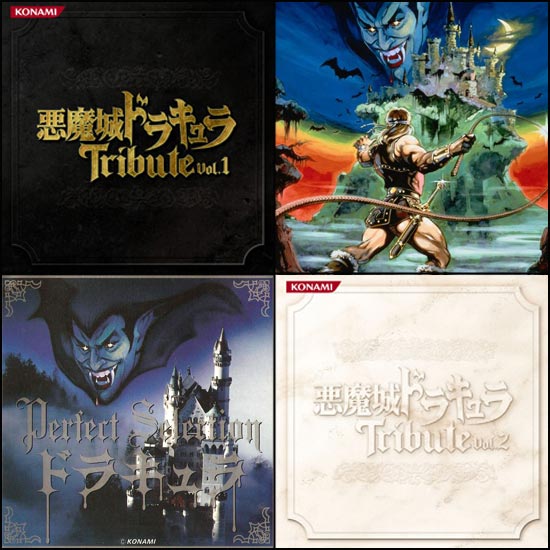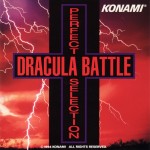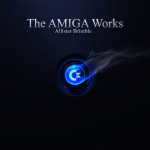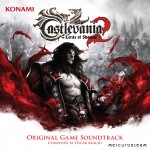As much as Gideon doesn’t want to admit it, fans continue to and always will love classic Castlevania music. I guess the team over at GEONDAN agrees, as it seems they were tapped to work on two arrangement albums dedicated to some of the most beloved tracks from the series. This is probably that “big project” Yuji Takenouchi was referring to when we interviewed him shortly after GEONDAN was formed.
So what’s here? How about a slew of talented game composers, many of your favorite Castlevania tracks, and two discs taking two drastically different directions?
Find out if they’re worth your time and money in our review after the jump.
The first thing to note is that these are two drastically different albums, as I mentioned above. Volume 1 is the heavier of the two, working in rock and electronic arrangements that are more in line with Castelvania arrangement albums of the past. Volume 2, on the other hand, is much softer, touching on everything from Celtic music to piano concertos, sounding more like an arrangement album for the Genso Suikoden series.
Well, let’s jump in, shall we?
If you didn’t get the reference to the terribly dated and disgustingly 80s (in a good way) Perfect Selection Dracula album in the title of this post, the first track here may not make much sense to you. The iconic “Vampire Killer” arranged by Tsukasa Masuko opens with that familiar creaky door, and a ridiculously cheesy, “Welcome to my castle, Mr. Vampire Killer!” A silly 1980s-style remix ensues, working in some fun rhythmic bongo fills and some nice variations in the chorus section, but the highlights are, of course, the vocals. Ponder this:
“Have you considered that the god who made humanity also made [vampires]? Just as people eat other animals, we also eat other living things.”
That’s deep. Thanks, Dracula.
Yuji Takenouchi treats us to a very loose electronic arrangement of “Bloody Tears” that takes a lot of liberties and only dabbles in the main melody, while Aki Hata rocks out with “Clockwork,” bringing in former Kukeiha Club and Sega S.S.T. Band member Koichi Namiki on guitar and bass and violinist Teppei Okada to give the track extra oomph (live players are also featured on MANYO’s arrangement of “New Messiah” later on the album). Denji Sano will get you on the dance floor with a straight trance remix of “Simon’s Theme,” and I love SuperSweep’s Yousuke Yusui’s chiptune version of “Divine Bloodlines.”
What I find really interesting about both albums is how each composer interprets the music using his or her own distinct style. This is really apparently on Volume 1 with Motoi Sakuraba’s arrangement of “Beginning” and Masafumi Takada’s “Slash.” You’d know each of these tracks were arranged by their respective composers even if you didn’t look at the album credits. Sakuraba does his progressive rock thing with some amazing bass, organ, and synth lead work, making me wonder how I never thought to ask myself, “What would a Castlevania game scored by Motoi Sakuraba sound like?” This is the answer, and it’s awesome. Similarly, Masafumi Takada takes us on a chopped up and distorted electronic journey wish “Slash,” which will remind you of his recent work on the highly atmospheric electronic score for Vanquish. In fact, the arrangement consists almost entirely of evolving electronic atmospheres, with the track’s main melody escaping only for a few fleeting moments here in there, which is an interesting approach.
To get to the same idea on Volume 2, you should immediately be able to pick out who arranged both “Lost Painting” and “Ending Theme.” The ethnic and organic electronic sounds of the former paired with the female singing should be reminiscent of the Panzer Dragoon series, and maybe a bit of the Celtic Collection series for the Suikoden series, and in fact, AKANE, the group behind the arrangement, does feature Suikoden series performer Yumiko Takahashi and Panzer Dragoon series composer Saori Kobayashi. They offer a non-traditional yet highly enjoyable arrangement of “Lost Painting,” which is one of the most popular themes from Symphony of the Night. “Ending Theme” from Super Castlevania is not only an amazing pick as one of my personal favorite tracks from the entire franchise, but the doubled-up woodwinds and heavy emphasis on belltones scream Hiroki Kikuta from a mile away. While I may prefer the original to the arrangement, I still appreciate Kikuta’s interpretation.
But I’m getting ahead of myself. Volume 2 actually opens with Basiscape’s Azusa Chiba’s arrangement of “THE SINKING OLD SANCTUARY,” a lovely and very loose Celtic arrangement that really sets the tone for the rest of Volume 2. This is sweet, this is elegant, and this is different from anything you’ve heard from the Castlevania series in the past. I offer major kudos to Manami Kiyota for another excellent pick from Symphony of the Night, “Requiem of the Gods,” which features a massive organ (I did just say that) and what sounds to be a real choir. It’s beautiful, although the general MIDI-esque percussion loop is a bit of a distraction.
Kumi Tanioka, who seemingly disappeared after leaving Square Enix, appears here at her most comfortable: at the piano. “Concert Hall without Applause” was always one of my favorite pieces from Lament of Innocence, and Tanioka’s graceful touch in this piano-only arrangement is a real treat. The same goes for Yoshino Aoki’s “Requiem of a Starlit Night,” which features her lovely voice alongside a powerful and convincing string arrangement. Even Masashi Hamauzu makes an appearance, working his magic with live strings and piano in “Finale ~Deep Translucent Moonlit Night.” While it’s not the most memorable theme, Hamauzu’s technique is apparent. I also dig Hideki Sakamoto’s piano solos and funky bassline in “An Empty Tome.”
While all I’ve offered is praise thus far, that’s not to say there aren’t a few duds. It’s not an issue of anything being horribly offensive to the ears, but more so that some of the tracks don’t stand out, or don’t offer much in terms of “arrangement.” Still, I’d say this is a pretty solid effort from a long list of talented composers.
In terms of packaging, each album comes with commentary on each track from the arranger. Not much else is included. Both discs have their strengths, but given the drastic shift in style featured on Volume 2, I’d have to say it’s my personal favorite. I think hardcore fans will find Volume 1 more traditional, and perhaps more to their liking. In any case, both albums are pretty hard to come by as far as online retailers go, but VGM World may be your best bet for international orders.
What do you think of the differences between the two albums? Do you have a preference for one style over the other, and are you as amused as I am by the throwback to Perfect Selection Dracula?
Tags: Akumajo Dracula, Arrangements, Arrangers, Castlevania, GEONDAN, Konami, Music Reviews, Remixes, Reviews









































These albums are amazing. An all-star compilation of composers arranging music from one of the most venerable game series’ of all time. I personally prefer the feel of Vol. 1 unsurprisingly, but Vol. 2 is just as good, and I can appreciate the different directions of both.